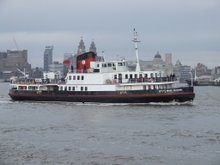Virgin lizard becomes new parent
A female Komodo dragon which laid fertilised eggs despite being a virgin is now a mother and "father" of five.
Flora produced a clutch of 10 eggs without mating at Chester Zoo, Cheshire, in May 2006.
Although other lizards reproduce this way, it has only recently been recognised in Komodo dragons.
The five male hatchlings are up to 18 inches (46cm) long and weigh about 4ozs (113g). Two eggs are still in incubation and three others collapsed.
The newborn lizards feed on locusts and crickets and can be seen at the zoo from Easter.
The hatchlings are black and yellow, but the bright colours will fade with time.
Genetic fingerprinting
Kevin Buley, curator of lower vertebrates and invertebrates at Chester Zoo, said: "Flora is oblivious to the excitement she has caused, but we are delighted to say she is now a mum and dad.
"When the first of the babies hatched, we didn't know whether to make her a cup of tea or pass her the cigars."
The hatchlings, who will be moved to an enclosure on public display at the zoo around Easter, will grow to three metres in length - the Komodo dragon is the world's largest lizard.
Mr Buley said the young reptiles had not been named yet.
"As Komodo dragons can live for over 40 years, we want to get the names just right," he said.
Threatened species
When Flora, one of the zoo's two female Komodo dragons, laid her eggs in May, they were put in an incubator where three collapsed.
On opening them, staff discovered they contained embryos, and genetic fingerprinting by scientists at Liverpool University showed Flora's eggs had developed without being fertilised by sperm - a process called parthenogenesis.
All Komodo dragons bred in this way will be male.
The new clutch are the first Komodo dragons to born at Chester Zoo, where Flora and sister Nessie are part of a European zoo breeding programme to protect the threatened species.
It is believed there are fewer than 4,000 Komodo dragons left in the world, and those living in the wild live on three islands in Indonesia, which they swim between.
While not poisonous, their saliva contains a host of deadly bacteria. In the wild they ambush and bite their prey and then track it for up to two days until it dies of blood poisoning
FOR MY 500TH BLOG A PICTURE OF FLORA TAKEN IN JULY 2005.
SO UGLY BUT SO BEAUTIFUL!!
Coincedentally on the same day this blog from Spain and in Spanish blatantly about the same thing, which as you know me well enough by now, well impressed me........
http://vidouensville.blogspot.com
otro punto para el Espiritu Santo
parece ser que tenemos a otra Maria entre nosotros."Flora es ajena a la emoción que causó, pero nos complace decir que ella es ahora mamá y papá"pd: me pregunto, los dragoncitos estos serán otros cinco mesias?
Loving Google's language tool the way I do
this roughly (very) translates to :
another point for the Spirit Santo
it seems to be that we have to another Maria between us. “Flora is other people's to the emotion that she caused, but she pleases to us to say that she is now mother and papa”
PS: I ask myself, the other five dragoncitos these will be mesias?
YES THEY WILL ALL BE MALE, READ ABOVE AND USE THE GOOGLE TRANSLATION TOOL THE OTHER WAY!
Wednesday, January 24, 2007
THE 500TH BLOG!
Reported by
SIMON
at
8:52 pm
![]()
Subscribe to:
Post Comments (Atom)







No comments:
Post a Comment